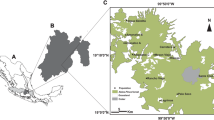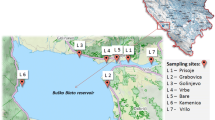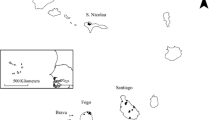Abstract
The houbara bustard (Chlamydotisundulata), the main quarry for Arab falconry,is currently threatened by excessive huntingand poaching as well as by habitat loss andfragmentation. We have investigated the geneticdiversity, population structure and demographichistory of houbara bustards across theirgeographical range by analyzing mitochondrial(mt)DNA sequences (a 370 bp fragment of controlregion I and a 264 bp fragment of thecytochrome b gene) and 4 microsatelliteloci in 74 individuals sampled from the CanaryIslands to China. Both markers revealed low tomoderate diversity that could be partitionedinto two monophyletic groups or evolutionarysignificant units belonging to the NorthAfrican (C. u. undulata) and Asian (C. u. macqueenii) subspecies. A history ofrelatively recent population growth (∼35,000years ago) accompanied by range expansion isthe most likely demographic scenario for theAsian subspecies. In addition, Macqueen'sbustards are able to disperse efficiently overbroad areas, which is consistent with ourinference of weak phylogeographic structure(global F ST = 0.20 and 0.04 formtDNA and microsatellites, respectively) andhigh levels of homogenizing gene flow on widegeographical scales. We therefore suggest thatmanagement actions should focus on maintainingmigratory connectivity between breeding andnon-breeding areas.
Similar content being viewed by others
References
Arctander P (1995) Comparison of a mitochondrial gene and a corresponding nuclear pseudogene. Proc. Roy. Soc. Lond. B, 262, 13–19.
Bochenski Z, Kurochkin EN (1987) Pliocene bustards (Aves: Otididae and Gryzajidae) of Moldavia and S. Ukraine. In: L'Evolution des oiseaux d+apres le temoignage des fossiles (ed Mourer-Chauvire C), pp. 173–186. Docum. Lab. Géol. 99, Lyon.
Broders O, Osborne T, Wink M (2003) A mtDNA phylogeny of bustards (family Otididae) based on nucleotide sequences of the cytochrome b-gene. J. Ornithol., 144, 176–185.
Clement M, Posada D, Crandall KA (2000) TCS: a computer program to estimate gene genealogies. Mol. Ecol., 9, 1657–1659.
Collar NJ (1996) Family Otididae (bustards). In: Handbook of the Birds of the World, Vol. 3. (eds. Del Hoyo J, Elliot A, Sargatal J), pp. 240–273. Lynx Edicions, Barcelona.
Combreau O, Saint-Jalme M, Seddon P et al. (1995) A program for houbara bustard restoration in Saudi Arabia. In: Integrating People and Wildlife for a Sustainable Future (eds. Bissonette JA, Kraussman PR), pp. 520–524. The Wildlife Society USA, Bethesda.
Combreau O, Launay F, Al Bowardi M, Gubin B (1999) Outward migration of houbara bustards Chlamydotis undulata macqueenii from two breeding areas in Kazakhstan. Condor, 101, 159–164.
Combreau O, Launay F, Lawrence P (2001) An assessment of annual mortality rates in adult Asian houbara bustards (Chlamydotis [undulata] macqueenii). Anim. Conserv., 4, 133–141.
Cramp S, Simmons K (1980) Handbook of the Birds of Europe, the Middle East and North Africa, Vol. 2. Oxford University Press, Oxford.
Crandall KA, Templeton AR (1993) Empirical tests of some predictions from coalescent theory with applications to intraspecific phylogeny reconstruction. Genetics, 134, 959–969.
D'Aloia M-A (2001) Studies on the population structure of the houbara bustard Chlamydotis undulata in the Middle East with DNA analysis techniques. Zool. Middle East, 22, 25–35.
Excoffier L, Smouse P, Quattro J (1992) Analysis of molecular variance inferred from metric distances among DNA haplotypes: application to human mitochondrial DNA restriction data. Genetics, 131, 479–491.
Fox N, Al Bowardi M, Macdonald H, Launay F (2000) A Global Strategy for the Conservation of Falcons and Houbara. Environmental Research and Wildlife Development Agency, Abu Dhabi.
Fu Y-X (1997) Statistical tests of neutrality of mutations against population growth, hitchhiking and background selection. Genetics, 147, 915–925.
Gaucher P, Paillat P, Chappuis C, Saint Jalme M, Lotfikhah F, Wink M (1996) Taxonomy of the houbara bustard Chlamydotis undulata subspecies considered on the basis of sexual display and genetic divergence. Ibis, 138, 273–282.
Goudet J (1995) fstat Version 1.2.: a computer program to calculate F-statistics. J. Hered., 4, 485–486.
Goriup PD (1997) The world status of the houbara bustard Chlamydotis undulata. Bird Conserv. Inter., 7, 373–397.
Granjon L, Gaucher P, Greth A, Paillat P, Vassart M (1994) Allozyme study of two subspecies of houbara bustard (Chlamydotis undulata undulata and C. u. macqueenii). Biochem. Syst. Ecol., 22, 775–779.
Haubold B, Wiehe T (2001) Statistics of divergence times. Mol. Biol. Evol., 18, 1157–1160.
Hilton-Taylor C (2000) IUCN Red List of Threatened Species. IUCN, Gland, Switzerland & Cambridge, UK.
Kocher TD, Thomas WK, Meyer A et al. (1989) Dynamics of mitochondrial DNA evolution in mammals: amplification and sequencing with conserved primers. Proc. Nat. Acad. Sci. USA, 86, 6196–6200.
Kimura M (1980) A simple method for estimating evolutionary rates of base substitutions through comparative studies of nucleotide sequences. J. Mol. Evol., 16, 111–120.
Kretzoi M (1960/61) Prähistorischer Großtrappenfund und die Geschichte der Trappen. Aquila, 67-68, 189–190.
Kumar S, Tamura K, Nei M (1993) MEGA:Molecular Evolutionary Genetics Analysis, Version 1.02. Pennsylvania State University, University Park.
Launay F, Paillat P (1990) A behavioural repertoire of the adult houbara bustard (Chlamydotis undulata macqueenii). Rev. Ecol. (Terre Vie), 45, 65–88.
Launay F, Combreau O, Al Bowardi M (1999) Annual migration of houbara bustard Chlamydotis undulata macqueenii from the United Arab Emirates. Bird Conserv. Inter., 9, 155–161.
Lieckfeldt D, Schmidt A, Pitra C (2001) Isolation and characterization of microsatellite loci in the great bustard, Otis tarda. Mol. Ecol. Notes, 3, 133–134.
Manly BFJ (1997) Randomization, Bootstrap and Monte Carlo Methods in Biology, 2nd edn. Chapman & Hall, London.
Martín CA, Alonso JC, Alonso J, Pitra C, Lieckfeldt D (2002) Great bustard population structure in central Spain: concordant results from genetic analysis and dispersal study. Proc. Roy. Soc. Lond. B, 269, 119–125.
Michalakis Y, Excoffier L (1996) A generic estimation of population subdivision using distances between alleles with special reference to microsatellite loci. Genetics, 142, 1061–1064.
Moore WS (1995) Inferring phylogenies from mtDNA variation: mitochondrial-gene trees versus nuclear-gene trees. Evolution, 49, 718–726.
Moritz C (1994) Defining 'Evolutionarily Significant Units' for conservation. Trends Ecol. Evol., 9, 373–375.
Müllenbach R, Lagoda PJL, Welter C (1989) An efficient salt-chloroform extraction of DNA from blood and tissues. Trends Genet., 5, 391.
Osborne PE, Al Bowardi M, Bailey TA (1997). Migration of the houbara bustard Chlamydotis undulata from Abu Dhabi to Turkmenistan: the first results from satellite tracking studies. Ibis, 139, 192–196.
Palumbi SR, Martin A, Romano S et al. (1991) The Simple Fool's Guide to PCR. University of Hawaii, Department of Zoology, Honolulu.
Pitra C, Lieckfeldt D, Frahnert S, Fickel J (2002) Phylogenetic relationships and ancestral areas of the bustards (Gruiformes: Otididae), inferred from mitochondrial DNA and nuclear intron sequences. Mol. Phyl. Evol., 23, 63–74.
Primmer CR, Ellegren H (1998) Patterns of molecular evolution in avian microsatellites. Mol. Biol. Evol., 15, 997–1008.
Rozas J, Rozas R (1999) DnaSP version 3: an integrated program for molecular population genetics and molecular evolution analysis. Bioinformatics, 15, 174–175.
Sanchez Marco A (1990) A new bustard (Otididae; Aves) from the early Pliocene of Layna (Soria, Spain). Paleontol. Evol., 23, 223–229.
Seddon PJ, Saint-Jalme M, Van Heezik Y, Paillat P, Gaucher P, Combreau O (1995) Restoration of Houbara bustard populations in Saudi Arabia: developments and future directions. Oryx, 29, 136–142.
Schneider S, Kueffer JM, Roessli D, Excoffier L (2000) ARLEQUIN, Version 2.01: A Software for Population Genetic Data Analysis. University of Geneva, Geneva.
Slatkin M, Hudson RR (1991) Pairwise comparisons of mitochondrial DNA sequences in stable and exponentially growing populations. Genetics, 129, 555–562.
Tajima F (1989) Statistical method for testing the neutral mutation hypothesis by DNA polymorphism. Genetics, 123, 585–595.
Thompson JD, Gibson TJ, Plewniak F, Jeanmougin F, Higgins DG (1997) The ClustalX windows interface: flexible strategies for multiple sequence alignment aided by quality analysis tools. Nucleic Acids Res., 25, 4876–4882.
Thorne JL, Kishino H, Painter IS (1998) Estimating the rate of evolution of the rate of molecular evolution Mol. Biol. Evol., 15, 1647–1657.
Troy CS, MacHugh DE, Bailey JF et al. (2001) Genetic evidence for Near-Eastern origins of European cattle. Nature, 410, 1088–1091.
Whitlock M, McCauley D (1999) Indirect measures of gene flow and migration: Fst not equal to 1/(4Nm-1). Heredity, 82, 117–125.
Author information
Authors and Affiliations
Corresponding author
Rights and permissions
About this article
Cite this article
Pitra, C., D'Aloia, MA., Lieckfeldt, D. et al. Genetic variation across the current range of the Asian houbara bustard (Chlamydotis undulata macqueenii). Conservation Genetics 5, 205–215 (2004). https://doi.org/10.1023/B:COGE.0000030004.51398.28
Issue Date:
DOI: https://doi.org/10.1023/B:COGE.0000030004.51398.28




